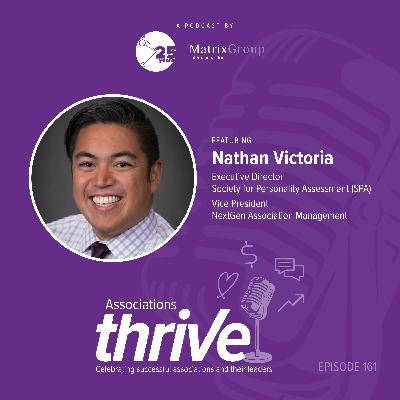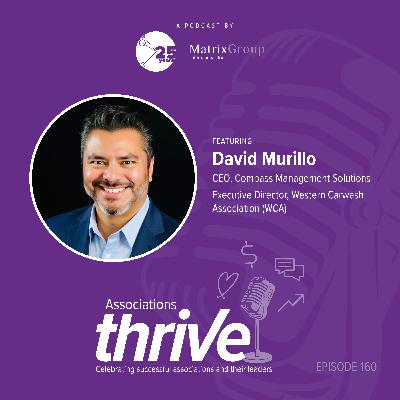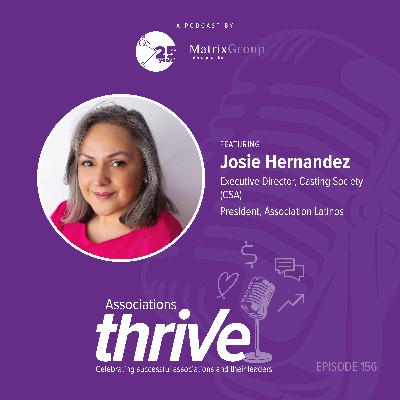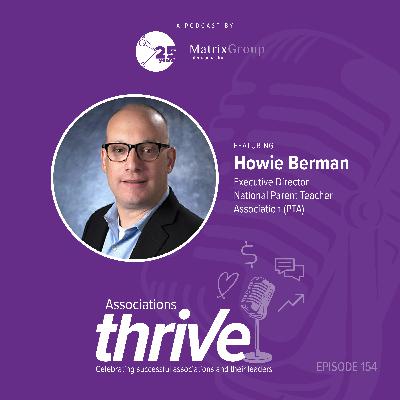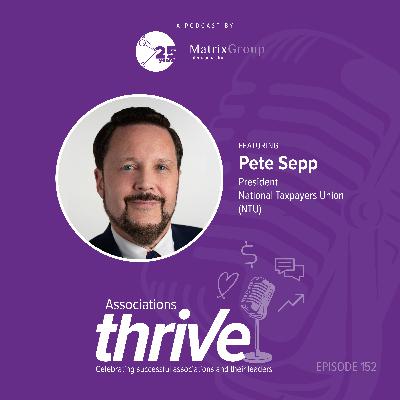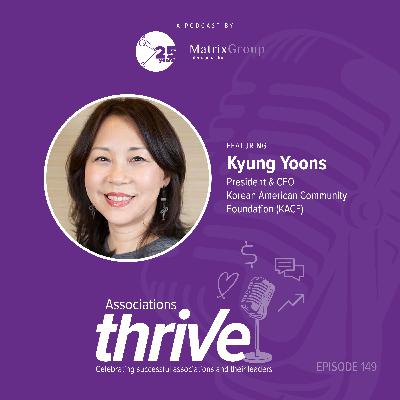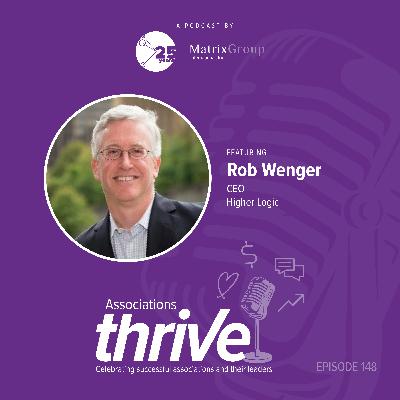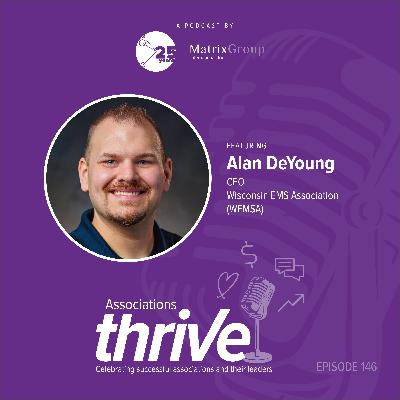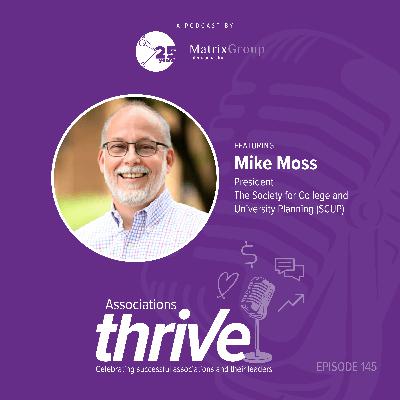Discover Associations Thrive
Associations Thrive

Associations Thrive
Author: Joanna Pineda
Subscribed: 2Played: 205Subscribe
Share
© Copyright 2025 Joanna Pineda
Description
This is Associations Thrive, the podcast celebrating successful associations and their leaders. Listen in as top association executives tell all, revealing the creative and innovative ways they’re increasing their bottom line, serving their members, and reimaging their organizations.
The Associations Thrive podcast is hosted by Joanna Pineda, CEO & Chief Troublemaker at Matrix Group International. Joanna’s personal mission and the mission of Matrix Group is to help associations and nonprofits increase membership, generate revenue and thrive in the digital space.
We believe that every association has a unique mission and unique story in how they’re serving their members, impacting their industry, and ultimately changing the world. Guests include top trade association, professional society, and non profit executives. We’re here to help amplify their stories so all associations can learn and thrive, together.
The Associations Thrive podcast is hosted by Joanna Pineda, CEO & Chief Troublemaker at Matrix Group International. Joanna’s personal mission and the mission of Matrix Group is to help associations and nonprofits increase membership, generate revenue and thrive in the digital space.
We believe that every association has a unique mission and unique story in how they’re serving their members, impacting their industry, and ultimately changing the world. Guests include top trade association, professional society, and non profit executives. We’re here to help amplify their stories so all associations can learn and thrive, together.
163 Episodes
Reverse
What does a small association need to go independent? And what does it take to transform an association into an entrepreneurial, nimble, and innovative organization?In this episode of Associations Thrive, host Joanna Pineda interviews Addy Kujawa, CEO of the American Alliance of Orthopaedic Executives (AAOE). Addy discusses:How AAOE supports orthopedic and musculoskeletal practice executives, primarily C-suite leaders focused on the business side of practices.The organization’s evolution from being managed by AAOS to becoming fully independent, and thereby saving costs, increasing agility, and creating a tight-knit, high-performing staff team.The challenges and logistics of relocating the association from Illinois to Indiana, hiring new staff, and setting up operations from scratch.Why independence was the right decision: complete control, direct board governance, nimbleness, and a culture of ownership.How Addy introduced EOS (Entrepreneurial Operating System) to improve accountability, strategic focus, and communication. They began with a 90-day pilot that transformed into a permanent operating model.The success of EOS in fostering innovation, sunsetting underperforming programs, and promoting team-wide accountability and ownership..A young professionals council that created a resource guide for new orthopedic execs, and a revamped webinar program that grew from 15 to 50 annual events.References:AAOE Website
What happens when schools don’t have enough psychologists to meet student needs? And how can associations help their members thrive in such an environment?In this episode of Associations Thrive, host Joanna Pineda interviews Eric Rossen, Executive Director of the National Association of School Psychologists (NASP). Eric discusses:How NASP represents over 24,000 school psychologists across the U.S., many of whom serve multiple schools due to a national shortage.The difference between school psychologists and school counselors, and why having both creates “force multipliers” for student success.NASP’s advocacy work around federal funding, including the fight to restore grant money that was being used to address workforce shortages.How NASP is addressing the mental health of its members, who often work in isolated environments, under high stress.Eric’s leadership journey from school psychologist to association executive, and how earning his CAE signaled a full embrace of his role as an association professional.His leadership style shift, from “doing” to empowering, and how he intentionally built trust when stepping into the Executive Director role.Why National School Psychology Week is more than recognition of school psychologists: it’s a tool for public awareness and appreciation of a critical profession.NASP’s upcoming 2026 convention in Chicago, expected to be its largest ever, with Dr. Miguel Cardona as the keynote speaker.How NASP is making its convention more expansive and impactful by welcoming affiliated organizations to host events under its umbrella, creating a “bigger tent” for school psychology.References:NASP WebsiteNASP Annual Convention
How do you redefine a field that’s widely misunderstood, even among its own professionals? And how can associations become essential hubs for interdisciplinary collaboration in such a space?In this episode of Associations Thrive, host Joanna Pineda interviews Nathan Victoria, Executive Director of the Society for Personality Assessment (SPA) and Vice President at NextGen Association Management. Nathan discusses:Why “personality assessment” doesn’t mean pop personality tests like Myers-Briggs or StrengthsFinder, but instead refers to integrated and multi-method clinical assessments used by psychologists.The clinical and legal applications of personality assessment, including for law enforcement, immigration, air traffic controllers, and reality TV casting.SPA’s historical roots as the Rorschach Institute, Inc., and how it’s evolving to reclaim and redefine personality assessment.The effort to define personality assessment within the organization and clarify its public perception.SPA’s reinvestment in infrastructure: website, branding, database, and strategic plan.The organization’s shift to AMC management through NextGen, and the benefits of a more efficient staffing model.How SPA supports international engagement with its first-ever conference outside the U.S., despite visa and travel challenges.SPA’s unique conference partnerships with smaller psychology organizations to share resources and cross-pollinate ideas.Nathan’s broader role in managing multiple associations simultaneously through NextGen and how technology and transparency enable success.References:SPA WebsiteNextGen AMC Website2025 Expert Insights on Personality Assessment Virtual Conference2026 SPA Convention
How do you lead when your industry is undergoing rapid transformation? How does an association respond when traditional revenue streams like trade shows are no longer viable?In this episode of Associations Thrive, host Joanna Pineda interviews David Murillo, CEO of Compass Management Solutions and Executive Director of the Western Carwash Association (WCA). David discusses:How Compass Management Solutions serves nearly a dozen associations with full-scale and à la carte management services.The diversity of the car wash industry, which mom-and-pop operations, full service car washes, express models, and self-serve stations. How the Western Carwash Association (WCA) represents 900–1,000 car wash locations across 12 Western states.Why members join WCA today, especially for advocacy in highly regulated states like California and Arizona.The decision to integrate WCA’s once-thriving trade show into The Car Wash Show and how they planned for the post-trade show future.How WCA doubled down on regional advocacy and launched targeted education for underserved segments like self-serve and in-bay automatic operators.WCA’s recent rebrand to “Wash, Connect, Achieve” to reflect a more national and values-driven identity.Compass Management’s internal framework of “Superior Experience Engineering,” which emphasizes empathy and intentionality in everything from board meetings to signage at events.David’s approach to cultivating association talent, including hiring for leadership traits and supporting professional development and volunteer engagement.His experience as a DELP scholar and the profound impact it’s had on his leadership journey and network.References:Compass Management Solutions WebsiteWCA WebsiteThe Car Wash Show
Craft beer transformed American tastes—so how does the industry stay relevant in a crowded, flavor-filled beverage market? How can associations support their members during a time of economic uncertainty and competition from larger players?In this episode of Associations Thrive, host Joanna Pineda interviews Bart Watson, President and CEO of the Brewers Association. Bart discusses:How the Brewers Association represents over 5,000 small and independent craft brewers across the U.S.The evolving landscape of the craft beer industry as it enters a mature, stable phaseThe impact of competing beverage innovations like hard seltzers, canned cocktails, and THC beverages on market share and consumer attention.The recent spin-off of the American Homebrewers Association and how both organizations benefit from their independence.The importance of renewed consumer education to engage new generations and promote local craft breweries.Why the Brewers Association continues to invest in consumer-facing platforms like CraftBeer.com and large-scale events like the Great American Beer Festival.How the association is rethinking its convention (Craft Brewers Conference® & BrewExpo America®) to focus more on business acumen, total beverage strategies, and meaningful networking.The significant challenges small brewers face with supply chain inflation, especially with aluminum and barley, and the association’s advocacy work on tariffs.Why gathering and analyzing data is a key member benefit, and how it helps level the playing field for smaller breweries.The role of local breweries in community life, especially during events like Oktoberfest, and how fresh hop beers are a seasonal must-try.References:Brewers Association WebsiteGreat American Beer FestivalCraftBeer.comEpisode 131 with Julia Herz
In this episode of Associations Thrive, host Joanna Pineda sat down with fellow association podcasters:Dave Coriale, President of Delcor Technology Solutions and host of Reboot ITKiKi L’Italien, Founder of Amplified Growth and former host of Association ChatBen Muscolino, CEO of Breezio and AMS Geek and host of The Association PodcastDave Will, CEO of PropFuel and host of Association StrongThey discuss:Their first concerts and how music shaped their identities.The books and podcasts that recently inspired them and sparked deep reflection.How they stay fresh and energized in an industry where many burn out.Personal stories of reinvention, introspection, and professional purpose.How slowing down, exercising, or leaning into purpose keeps them going.What they're working on now — from AI projects to book writing to redefining legacies.What they’re proud of in their association work.How connecting with others can be one of the most rewarding aspects of the work.Their love for the association community and the power of genuine conversations.References:Change Your Story, Change Your LifeThe Annotated Alice by Lewis CarrollThe Hard Thing About Hard Things by Ben HorowitzThe Telepathy Tapes podcast
How can humanitarian organizations respond more effectively to both natural disasters and systemic inequities around the globe? What is the role of empathy, listening, and local leadership in disaster response?In this episode of Associations Thrive, host Joanna Pineda interviews Sharon Eubank, Executive Director of Humanitarian Services of the Church of Jesus Christ of Latter-day Saints. Sharon discusses:How the Church’s humanitarian mission is an outward expression of faith, guided by the principle of loving all people regardless of geography, faith, or politics.The global priority of supporting children under five, including maternal health, vaccinations, nutrition, clean water, and early development.How public health leadership from women in the 1800s shaped their modern initiatives.Why development efforts must be locally led and how assumptions from outside can lead to ineffective or even harmful aid.The impact of intensifying global disasters and responding to seven “100-year” disasters in just one year.The scale of their work: over 3,800 projects, $1.45 billion spent, and 6.6 million volunteer hours across 192 countries.Her new book, Doing Small Things with Great Love, and the key principle that “money is only half the answer.”Her leadership principle: “My solution to your problem will always be wrong. The answer is inside you.”How anyone can start helping by simply visiting their local school or city council and asking, “What do you need?”References:LDS Humanitarian Services WebsiteGet Sharon’s brand new book!
How do you lead a volunteer-run organization into its next phase of growth without losing its identity and heart? And how can associations support members who are often behind the scenes but shape what the world sees?In this episode of Associations Thrive, host Joanna Pineda celebrates Hispanic Heritage Month with returning guest Josie Hernandez, Executive Director of Casting Society (CSA) and President of Association Latinos. Josie discusses:How Casting Society represents global casting professionals working in film, TV, theater, reality, commercials, and new media.The Society’s advocacy that led to a new Academy Award category for casting, debuting at the 2026 Oscars, a monumental achievement for the profession.How Josie led CSA’s transition from a volunteer-run structure to professional management through her firm, Bostrom.The business processes, governance practices, and SOPs that helped Casting Society grow revenue, membership, and influence.How CSA supports its diverse membership through its Training and Education Program , delivered by Casting Society Cares, which helps casting assistants advance their careers.The unique Artios Awards, held simultaneously in three cities, Los Angeles, New York, and London, to honor excellence in casting across media.Association Latinos’ signature event, Conexiones, a one-day summit designed around cultural leadership and lived experience, taking place October 10 in Chicago.How Association Latinos has grown organically, yet intentionally, with a volunteer base that now helps lead programming and strategy.References:CSA WebsiteArtios Awards EventsAssociation Latinos WebsiteConexiones EventJosie Hernandez on episode 59 of Associations Thrive about Association LatinosJosie Hernandez on episode 109 of Associations Thrive on the Workforce Trends Survey
If instant translation is in everyone’s pocket, why learn another language? How do associations continue to provide value in the face of thriving social networks, AI,and challenges to traditional membership programs?In this episode of Associations Thrive, host Joanna Pineda interviews Larry Paska, Executive Director of the American Council on the Teaching of Foreign Languages or ACTFL. Larry discusses:ACTFL as the “original social network” for world language educators.A field-wide focus on quality and proficiency: standards, teacher-prep guidance (via accreditation partnerships), and research that maps what languages are taught and where.Language proficiency assessments developed by ACTFL and administered via an exclusive licensee that drives important revenue for the association. The Language Connects Foundation’s scholarships for teachers and students, micro-grants for research, and initiatives that raise the profile of language learning.How AI in language learning isn’t a replacement for teachers, but a tool to support personalization and deepen learning.Dual-language immersion as a compelling model because it builds true proficiency and deepens cultural understanding.How ACTFL has maintained DEI as a strategic pillar because you can’t have multilingual and multicultural without DEI.How employers need staff who can communicate across languages.References:ACTFL website
How do we support children in school and beyond, especially during a time of cultural, political, and economic fragmentation? What role can associations play in elevating the power of families and communities in education?In this episode of Associations Thrive, host Joanna Pineda interviews Howie Berman, Executive Director of the National PTA. Howie discusses:The mission and reach of the National PTA as the oldest child advocacy organization in the U.S.Why membership is open to all—not just parents—and the importance of shared community responsibility.The unique challenges of leading a professional association whose members are not tied by a single profession.How National PTA is professionalizing volunteerism by offering structured training and envisioning certification tracks.Howie’s first 90 days as Executive Director, which included a “listen and learn” tour across state PTAs, and conversations with past presidents and partners.The importance of amplifying student voices, reimagining events, and removing barriers to leadership in traditional organizational structures.Challenges in federated membership structures and how National PTA is working to improve visibility and communication.National PTA’s commitment to equity, including multilingual resources and engagement of families in Title I districts.References:National PTA Website
How do associations support an industry as fast-changing and influential as advertising? How can associations nurture the next generation of professionals while advocating for policy that protects the industry?In this episode of Associations Thrive, host Joanna Pineda interviews Steve Pacheco, President and CEO of the American Advertising Federation (AAF). Steve discusses:The four pillars of AAF’s mission: education and lifelong learning, events and recognition, advocacy and government affairs, and diversity, equity, and inclusion.The Mosaic Center and its 30-year commitment to DEI in the advertising space.The strength of AAF’s multilevel membership: students, professionals, and corporate members like Google, Meta, and TikTok.AAF’s student engagement efforts, including the National Student Advertising Competition (NSAC) and the Most Promising Multicultural Students program.How AAF pivoted during the pandemic, replacing 33% of live event-driven revenue with virtual programs and strengthening club communications.AAF’s strong focus on workforce development and real-world student education to address industry recruitment gaps.The AAF's leadership in government affairs, including opposition to ad taxes and engagement with lawmakers on AI, privacy, data usage, and advertising to children.AAF’s advocacy in a fragmented policy environment—federal, state, and international—where lawmakers often lack understanding of the advertising ecosystem.Why Steve believes the advertising industry is undergoing the most dynamic transformation in 50 years, and how AAF is helping members adapt and thrive.References:AAF Website
What does it mean to advocate for taxpayer rights in an increasingly polarized political landscape? Can alliances between the left and right yield real reform in tax policy?In this episode of Associations Thrive, host Joanna Pineda interviews Pete Sepp, President of the National Taxpayers Union (NTU). Pete discusses:How NTU, founded in 1969, is a nonpartisan organization focused on simpler, fairer, lower taxes, less wasteful spending, and taxpayer rights.NTU’s mission to fill gaps in the tax policy advocacy space, working on issues that other organizations ignore or overlook.Why NTU identified IRS reform as a key issue — and how they view it as a human rights concern, not just a policy issue.How NTU built a diverse coalition — including organizations like the ACLU and La Raza — to push for taxpayer rights reforms.NTU’s creation of the Taxpayer Defense Center to pursue public interest litigation in precedent-setting tax cases.How the NTU Foundation’s “Tax Basics” provides factual, accessible answers to common taxpayer questions.The internal practices that earned NTU a spot on Washingtonian’s “Best Places to Work” list, including entrepreneurship and low internal politics.Pete’s philosophy that association CEOs must focus on the “Four M’s” — Money, Money, Money, and Money — to lead effectively.His success in working across ideological lines by reading opposing viewpoints, reaching out, and finding common ground.References:NTU WebsiteWhich States are Best for Remote Workers? 2025 Remote Obligations and Mobility (ROAM) Index - Foundation - National Taxpayers UnionNTU’s Taxpayer Defense CenterInside the One Big Beautiful Bill Act: Major Tax Provisions and Their Impact - Foundation - National Taxpayers UnionNTU’s Taxpayers for IRS Transformation18 Great Places to Work in the DC Area
What is the mood of association executives in 2025? How are Associations utilizing AI to power their organizations?In this special episode of Associations Thrive, host Joanna Pineda is joined by colleagues from Matrix Group International, Inc.: Dave Hoernig, Vice President of Software Engineering, Jessica Parsley, Director of Project Management, and Tanya Kennedy Luminati, MatrixMaxx Product Manager. They look back on the trends they’re seeing in the association space. They discuss:How the mood among associations is cautious and uncertain, with many waiting to see how year-end dues renewals, product sales, and event registrations pan out.Budget planning for 2026 is underway, and how most organizations are projecting lean years, but many remain hopeful and continue planning.How associations are prioritizing technology integrations to connect their AMS, LMS, CRM, community platforms, and advocacy tools.How careful planning, frequent communication, and realistic budgeting lead to successful integration projects.How associations want their websites to tell the story of their industry or profession to the public, policymakers, and potential members.The importance of storytelling in recent website redesigns, including The Fertilizer Institute’s “Why Fertilizer” section and the American Counseling Association’s “Learn About Counseling” navigation item.Associations are cautiously implementing AI tools, such as read-aloud functionality, chatbots, and AI-powered search, while being mindful of privacy and costs.How preparing content for AI answer engines similar to SEO, but with key differences. Associations must focus on having indexable content, page summaries, and FAQs that answer commonly asked questions.How many associations are experiencing CEO transitions.References:Matrix Group WebsiteTFI’s Why FertilizerACA’s What is Counseling?An example of read aloud functionality using AI
How can undergraduate research prepare students for civic engagement in a complex world? How should associations respond when the work of their members is under attack?In this episode of Associations Thrive, host Joanna Pineda interviews Lindsay Currie, Executive Officer of the Council on Undergraduate Research (CUR). Lindsay discusses:CUR's mission to expand access to undergraduate research and its proven long-term impact on student success, graduation rates, and civic engagement.The current challenges facing CUR members, including political and funding pressures on research and higher education.The organization's new strategic plan, CUR 2030, which features three major goals and includes cross-cutting themes: broadening participation, organizational sustainability, and communication.The decision to shift from “DEI” language to “broadening participation” to maximize inclusivity and participation, while still preserving the core values.CUR’s investment in a board coach to help shift from a “doing board” to a “strategic board” culture, and how that coach continues to foster executive and board collaboration.A rigorous and confidential nominations process that improves the quality and alignment of board candidates, avoiding the pitfalls of popularity contests.A layered onboarding process for new Board members, including coaching, board retreats, and annual reorientation to ensure all board members are aligned and equipped to lead strategically.CUR's emphasis on data, standards, and recognition to position itself as a leader in undergraduate research across higher education institutions.A comprehensive rollout strategy for the new plan, starting with CUR's 300 elected volunteers and culminating in a Fall 2025 campaign for the broader membership.References:CUR WebsiteLindsay Currie’s Previous Episode on Associations Thrive from October 2022ASAE’s ForesightWorks Framework
What does it mean to be a philanthropist in a community that historically hasn’t seen itself that way? What if associations not only advocated for their members, but also mobilized them to give, together?In this episode of Associations Thrive, host Joanna Pineda interviews Kyung Yoon, President and CEO of the Korean American Community Foundation (KACF). Kyung discusses:How KACF was born out of a dinner conversation among Korean American professionals who wanted to give back to their community.The impact of the “model minority” myth on Korean and Asian American communities, and how it can obscure real needs.How KACF started with a grassroots “Dollar a Day” campaign to fund grants to Korean American nonprofits.Why KACF chose to become a community foundation and what that means for how they raise and distribute funds.How KACF has distributed over $17 million in grants since its founding in 2002, including over $3 million last year alone.The broad range of issues KACF funds to build economic security, from food insecurity to housing, health, and domestic violence.KACF’s commitment to systemic change, not just direct service, funding advocacy, and policy change efforts.How the Giving Summit engages the Korean American community in thoughtful, intentional philanthropy.How receiving a grant from MacKenzie Scott validated KACF’s work and expanded its impact.Kyung’s vision for a future where Korean Americans see themselves as funders and philanthropists with the power to uplift their own communities.References:KACF WebsiteMusic from #Uppbeat (free for Creators!):https://uppbeat.io/t/zoo/clarityLicense code: RQWZMZXYSBVT16ZW
How can associations remain relevant and valuable in an AI-driven world? How do associations create new knowledge while serving as the second source of truth in a world when search is dominated by AI engines?In this episode of Associations Thrive, host Joanna Pineda interviews Rob Wenger, CEO of Higher Logic. Rob discusses:Why people are prioritizing human connections over content at conferences, and how associations can support meaningful, year-round engagement.How Higher Logic’s Thrive platform integrates community, mentoring, volunteering, and marketing in a single ecosystem.Why virtual connections can be just as valuable as in-person ones, and how community platforms can reach younger and mid-career members who often don’t attend in person events.Why it’s a myth that trade associations can’t do online community due to competition, and what the data really shows.The existential threat to associations that delayed AI adoption creates, and why the window to act is closing fast.How Higher Logic is using AI and big data to automate over 200 types of marketing campaigns that associations often don’t have the resources to do.Why associations must become "the second answer engine" for their members when AI tools fall short.The role of associations in generating expert, original content that will feed and sustain AI innovation in the future.Rob’s journey from CTO to CEO, how he intentionally developed leadership traits over 20 years, and why he came out of retirement to lead Higher Logic again.References:Higher Logic WebsiteHigher Logic’s Thrive productHigher Logic’s 2024 Association Member Experience ReportHigher Logic’s 2024 Association Email Benchmark Report
What happens when the people we count on to save lives… stop volunteering? How can associations support vital, yet undervalued, professions in today’s economy?In this episode of Associations Thrive, host Joanna Pineda interviews Alan DeYoung, Executive Director and CEO of the Wisconsin EMS Association (WEMSA). Alan discusses:The persistent challenge that EMS in Wisconsin is not legally mandated, leading to gaps in emergency care access across the state.A new state reimbursement program that will make EMS education free for Wisconsinites, removing financial barriers for individuals and employers alike.How WEMSA advocates for EMS through legislative efforts, including Alan becoming a registered lobbyist to deepen his influence and connections.The role of community-led initiatives, such as HOAs training members as first responders in rural areas.Why Alan believes being an outsider to the EMS profession strengthens his unbiased leadership and operational support role.How WEMSA uses tech stack reviews and system automation to maximize the impact of their small team.The importance of in-person member visits for member engagement, advocacy, member retention, and program development.A creative, non-dues revenue initiative to help EMS departments cover more of their costs by recovering patient insurance information that is often not collected in the rush of an EMS call.Why associations that implement education or industry-specific programs are more likely to thrive long-term.References:WEMSA Website2022 Associations Thrive interview with Alan DeYoung
How do you honor the legacy of a founding executive and also bring innovation, structure, and new energy to an organization? How can associations build strong member relationships, especially during leadership transitions?In this episode of Associations Thrive, host Joanna Pineda interviews Dr. Celia Zamora, Executive Director of the American Council of Academic Physical Therapy (ACAPT). Celia discusses:How ACAPT is a trade association representing over 270 graduate-level physical therapy programs across the U.S.How physical therapy as a profession continues to grow due to factors like an aging population and new trends like "pickleball injuries." Celia’s nontraditional path to becoming an association CEO, including her PhD in Applied Linguistics.The impact of ASAE’s Diversity Executive Leadership Program (DELP) on her career trajectory.How she navigated the transition as ACAPT's second-ever Executive Director, honoring the founding leader’s legacy while introducing structure, processes, and accessibility.The listening tour she embarked on with members, including conversations with those who did not renew membership, to improve transparency and communication.ACAPT’s upcoming Education Leadership Conference, which marks the beginning of the next decade for the organization under new leadership.Plans to expand ACAPT’s global presence and foster international partnerships in physical therapy education.References:ACAPT Website
How do we prevent strategic plans from sitting on a shelf and instead embed them into an organization's DNA? How can associations become true communities of practice where learning and innovation are peer-led?In this episode of Associations Thrive, host Joanna Pineda interviews Mike Moss, President of the Society for College and University Planning (SCUP). Mike discusses:SCUP’s mission as a professional society focused on integrated planning in higher education.The difference between strategic planning and integrated planning—ensuring plans are continuously executed, aligned, and adjusted across departments.Why SCUP’s members are often responsible for planning, even when it’s not in their job titles.SCUP’s new strategic plan that emphasizes becoming a peer-led community of practice rather than an expert-driven organization.Major structural changes to governance, including a new set of flexible bylaws and reimagined committees to better support member collaboration.The transition of SCUP staff—via retirement and new hires—to reflect the new direction, along with upskilling existing staff.Enhancements to their annual conference to foster group-based learning and peer-driven sessions.The SCUP Exchange, a digital collaboration platform that empowers members to connect and lead discussions without top-down oversight.A new, simplified, and more affordable membership model designed to increase access and participation across campuses.References:SCUP Website
What happens when your mission to support underrepresented communities in academia suddenly comes under political scrutiny? And how can your association stay true to its values while navigating legal and societal change?In this episode of Associations Thrive, host Joanna Pineda interviews Alfonzo Alexander, President and CEO of The PhD Project. Alfonzo discusses:How The PhD Project recruits business professionals from diverse backgrounds to pursue PhDs and become business school faculty.The organization’s impact in increasing the number of underrepresented faculty from just 250 in 1994 to 1,600 today.Why the organization is still vital, as faculty of color make up less than 4% of all business school professors.The “mentor effect,” wherein representation among faculty encourages underrepresented students to pursue academic and business careers.The shift in application policies to remove demographic requirements in response to investigations under the Trump administration.The organization’s efforts to support members through mentorship, community-building, and guidance—not financial aid.Continued strength in the PhD pipeline and a highly attended 2025 conference, even amidst institutional pressures.New revenue diversification efforts, including partnerships, masterclasses, and showcasing thought leaders from within the PhD Project community.References:The PhD Project WebsiteAssociations Thrive episode 69 with Blane Ruschak, former President of The PhD Project




